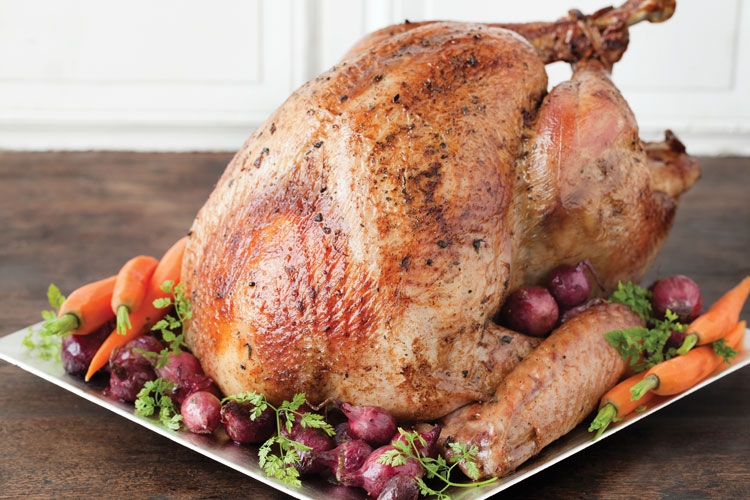Talking Turkey
Join Michael Clauss, City Market’s Executive Chef, as he demonstrates a variety of tips, tricks, and techniques to help your Thanksgiving meal prep go smoothly this year.
Thanksgiving Cooking Episode 5:
Leftover Turkey Sandwich
Thanksgiving Cooking Episode 4:
Carving Your Turkey
Thanksgiving Cooking Episode 3:
Pumpkin & Sweet Potato
Thanksgiving Cooking Episode 2:
Brining Your Bird & Simple Pan Gravy
Thanksgiving Cooking Episode 1:
How to Choose the Perfect Turkey & Making Stock
Helpful Insight for Your Turkey
Need some turkey tips to get you started this holiday season? Use this guide to learn how to thaw, brine, and roast your turkey. We also include ideas on using local vegetables in your side dishes and a recipe for turkey broth!
Thawing a Frozen Bird
To thaw in the refrigerator: Keep the turkey wrapped and place it in a pan. Let it stand in the refrigerator 24 hours for every 4 pounds of turkey. The giblets and the neck may be removed from the bird near the end of the thawing period. If you're interested in using the giblets and neck for gravy, refrigerate until you are ready to use.
To thaw in cold water: Make sure the turkey is packaged in a leak proof bag to prevent bacteria from being introduced from the surrounding environment and so the turkey does not absorb any water. Change the cold water every 30 minutes. Approximately 30 minutes per pound of turkey is required to thaw. After thawing, cook immediately.
Turkey Tips from our Executive Chef
With all of the information out there, it can be hard to decide on your best course of action when prepping the big bird. Our Executive Chef, Michael Clauss, keeps it simple with these basic tips.
Choosing a size - When planning your meal, keep in mind that you’re looking for about 1.5 lbs of turkey per person. For example, if you’re hosting a group of 10, you’ll want to get a 15 lb bird.
Cutting the bird - To maximize yield, make sure your carving knife is extra sharp. Electric carving knives work well too.
Tying - If you are tying your own bird, make sure not to tie it too tight – this can extend the cooking time and have an effect on keeping the bird moist.
Adding flavor - Adding (local) apples to the cavity or roasting pan can give your turkey an extra sweet and seasonal flavor profile.
Brining - Brining is a great way to achieve a moist turkey on Thanksgiving Day. Infusing fresh herbs and spices into the brine allows the turkey to take on a subtle aromatic flavor. See our brine recipe for details.
Pre-Salting is the Key to a Juicy Bird
Bring your fresh bird home at least two days before Thanksgiving. This will allow time to pre-salt, a simple step that keeps the turkey juicy and intensifies its natural flavors. The salt will gently permeate the meat, improving the water-holding ability of the muscle cells so that, when cooked, the turkey stays juicy yet does not become overly salty.
- (One or two days before Thanksgiving) Remove the giblets from the turkey, and refrigerate them for later use (such as making giblet gravy).
- Pat the turkey dry with towels.
- For a 14 lb bird, sprinkle two tablespoons of kosher salt and one teaspoon of freshly ground black pepper liberally all over the turkey, spreading a little in the cavity and being sure to season the back, the breasts, and the meaty thighs. Note: If you’ve never pre-salted before, this may look like too much salt, but it’s not. There is no need to rub the salt under the skin, it will work its way through the meat.
- Cover and return the turkey to the refrigerator for 24 to 48 hours. If possible, leave the turkey uncovered for the last 8 to 12 hours in the refrigerator to help the skin dry.
Note: when you pull the turkey from the fridge after its salt treatment, the skin will be taut and dry with no trace of salt.
Roasting Your Turkey
Remove any giblets from the cavity and reserve for the gravy. Submerge turkey into already prepared brine bucket with bag (see brine recipe). Brine for 8 to 12 hours. Refrigerate.
Remove turkey from brine and pat dry with paper towels. Place turkey, uncovered, on a baking sheet. Return to the refrigerator for 4 to 6 hours to dry out the skin (this step is optional, but does help the bird achieve a crispier skin).
When you are ready to cook the turkey, remove it from the refrigerator and allow it to come to room temperature for one hour.
Heat oven to 425° F. In the bottom of a large roasting pan, add the turkey stock to fill the pan to a ½ inch depth. Add the onions, carrots, garlic cloves, and bay leaves to the pan.
Add the dressing/stuffing into the cavity. If you are choosing not to stuff, add onions, garlic cloves, and thyme into the cavity.
Place turkey (breast side up) on a roasting rack set inside the roasting pan. Brush the turkey skin generously with melted butter, transfer roasting pan to the oven and roast for 25 minutes. Reduce oven temperature to 325° F and continue. If turkey starts to get too brown, loosely cover breast with aluminum foil.
Roast turkey until an instant-read thermometer inserted into the thigh reaches an internal temperature of 165° F. See Roasting Timetable on back. Juices should be clear. Let rest in pan for 30 to 45 minutes, covered. Transfer turkey to a cutting board and carve.
